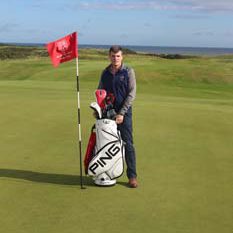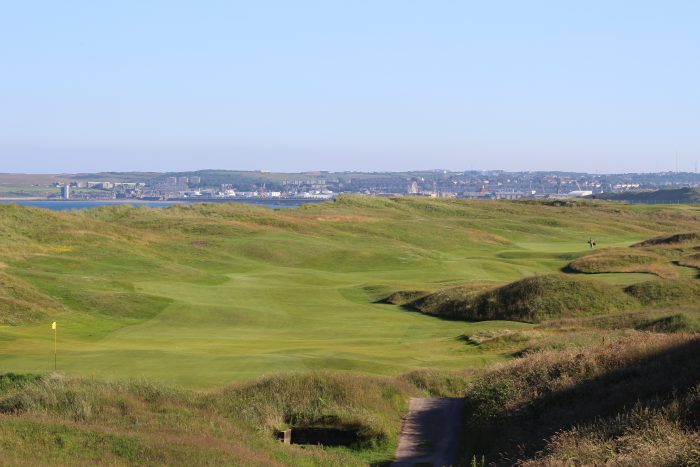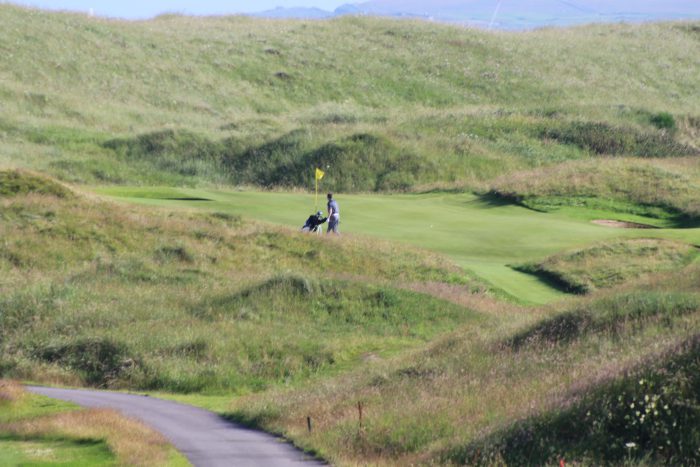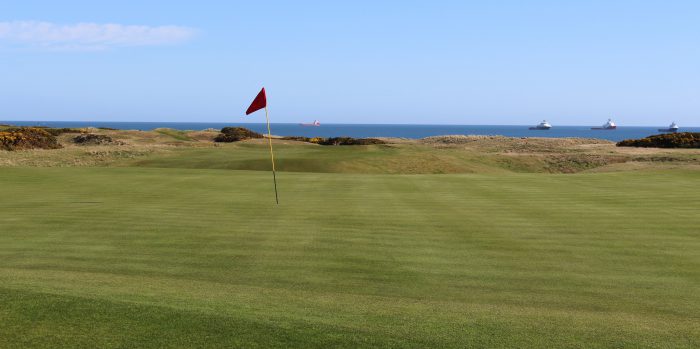Meet the head PGA professional: Royal Aberdeen’s David Ross
David talks about how his role has changed in the last three decades, preparation for prestigious events and making the most from the pro shop

What year did you turn professional and what have been your career highlights to date?
I took the path of becoming a PGA professional in 1989 at Royal Aberdeen under the guidance of Ronnie MacAskill. In 1994 I was given the opportunity to become the club professional at Drumpellier Golf Club in Coatbridge. An excellent grounding for my first position as a club professional. I then moved to Glenbervie Golf Club as club professional in 2002 from John Chillas who had just retired to play on the European Seniors Tour. Although a relatively young club compared to Royal Aberdeen, we probably most associate Glenbervie with the great John Panton MBE, who was club professional for nearly 40 years. In 2008 the position of club professional at Royal Aberdeen Golf Club became available when Ronnie MacAskill retired as the pro after 33 years. I was delighted to be offered the position and the chance to return to the club where I had started my career in golf 14 years before.
Since my return to Royal Aberdeen the club has hosted several great tournaments but The Walker Cup is probably the highlight for me. When you looked at the US team that year it was an impressive line up: Speith, English, Henley, Cantlay, Uihlein, Kraft to name but a few. The GB&I team was made up of players like O’Sullivan, Lewis, Senior, Brown, Byrne who are all very good players. However, when you looked at the Amateur World Rankings just before the event started, it was very one sided, the USA team were all within the top 12 and GB&I had only one player in the top 40. Like their professional counterparts in team competitions, the camaraderie and spirit of the GB&I team was very high and they all produced some great performances. Apart from a little help from mother nature, blustery showery conditions over the weekend, this was a fantastic win for team GB&I.

How has your role as a PGA professional changed since 1989?
The day-to-day aspects of the job have changed slightly from club to club. However, I would definitely say that as a PGA professional we’ve adapted our role as club professional to meet the demands of today’s golfer from 26 years ago. Whether it is interaction with the membership through social media, online lessons or ball flight technology when club fitting, we continue to meet and hopefully exceed those demands. Although my own golf game is somewhat rusty I still get the biggest kick out of having a career within the sport I love the most. Oh and the view from my office window is pretty decent!

Royal Aberdeen has been home to some prestigious events such as The Walker Cup and the Scottish Open – what has your involvement been in helping organise and run these? What advice would you give to pros preparing to hold big events at their clubs?
Since my return to Royal Aberdeen I have been fortunate to be involved with a number of tournaments the club has hosted with the highlights being The Walker Cup in 2011 and the Scottish Open in 2014. Two great events run by two different golfing bodies – R&A and the European Tour. The European Tour runs tournaments week in, week out so, for the Scottish Open, both the club and myself had very little involvement. The Walker Cup was a much more inclusive event for the club with involvement from about 75 per cent of the membership in varying roles – marshals, transport, clubhouse and so on. During the event, the pro shop was moved to a temporary tented shop as the BBC was given use of the pro shop. Although it created a slight headache with moving stock, it turned out well for size and handling customer flow, which was particularly busy when a match finished. My team were also in charge of the practice ground facilities for the tournament and finding the caddies for the USA team. It wasn’t just as simple as selecting the best 10 caddies – we also had try and match up personalities and traits. It felt a bit like Blind Date at first but we got there in the end.
The decisions to host tournaments at the club are normally made well in advance. This will give you plenty of time to plan ahead and prepare for a competition. If the tournament has been or is being held at another club prior to the year it is being held at your club, then I would recommend visiting the venue and contacting that club’s professional. Any information you can gain on the way previous venues have bought and merchandised their stock, suppliers, staffing, marketing, external venues and so on will be extremely helpful to your own preparation. When planning committees are formed for these events try to be involved as much as possible with them because, as a PGA professional, your input and advice will certainly be required. You might find your role as club professional is stretched somewhat from the norm and that is good but expect a long working week(s)! What I would stress is make sure you take time to actually watch and enjoy the tournament.

Royal Aberdeen will be on a lot of golfers’ radar when visiting Scotland but what marketing does the club do to ensure it’s maximising visitors?
Royal Aberdeen’s profile has certainly been raised with events like The Walker Cup and Scottish Open being held here and this, coupled with the recognition the championship course continually receives, has contributed tremendously towards advertising the golf club around the world. The secretary and administration team currently work with a number of golf tour operators, the likes of Perry Golf, Bonnie Wee Golf, St Andrews Golf Experience, Trump Scotland and many more in the UK and worldwide, to maximise the usage of tee times available for visitor play at Royal Aberdeen.
What advice would you give to anyone looking to pursue their career as a PGA pro? What skill sets do you believe a PGA pro should have?
Obviously playing professionally is probably a major part of anybody wishing for a career as a PGA pro, but the fact that the PGA training course is now designed to prepare the individuals for a much broader base to meet the needs of the golfing industry is fantastic. Hopefully individuals who choose this career have succeeded at the ‘PGA University Degree Course’ which leads to many different avenues within a golf career. Speak to your local PGA professional, ask them questions about their career and also contact the PGA headquarters at the Belfry for information.
There are a lot of clichés that I could offer here – but consistency to your membership and dedication to the job are vital components I believe to being a successful PGA club professional.

How do you market and stimulate interest in your retail business? What determines the product range you carry and are there any companies helping you?
The way I market my services has certainly changed since I started. Back then it was a postal mail shot which was expensive and slow. Now, with the help of TGI, my buying group assists me with marketing tools which means we are able to interact with members and customers instantly through social media – Twitter, Facebook and so on; and e-newsletters, bespoke point-of-sale which help greatly to running a successful business. TGI also provides support with retail assistance and training, golf days, team events and supplier events. Having just recently added TGI Travel to the group we can now offer members golfing holidays, coaching breaks or even trips to see tournaments around the world. When it comes to choosing the correct products to carry I use an EPoS system by Crossover. In conjunction with TGI I’m able to pull a great deal of information from this to determine the companies and the range of products to stock which best serve my members and visitors.

What is the size of your junior section? What is the club doing to help introduce juniors to the game?
Like a lot of golf clubs, the junior section numbers have gone up and down over the years, but currently we have a fairly healthy section. The club has supported and initiated ClubGolf in the past with reasonable success. Currently the junior convenor has been running an initiative with parents whose children and their siblings or friends who are not old enough to join the club as a junior, under 10, are given the chance to play taster sessions around our Siverburn course. At no cost to the individuals these sessions involve some initial PGA coaching followed by playing six holes with on-course help. They have proved popular with the kids with the hope that they will continue into our junior membership when old enough.
Do you also offer free coaching programmes to introduce beginners to the game? Or any women-only coaching?
Unfortunately, Royal Aberdeen has limited practice facilities, so when we host a large tournament the club will use part of the Silverburn course as the practice area. We do have a sizeable short game area which is well used by us for tuition and practice by members. We offer a number of coaching sessions to Aberdeen Ladies Golf Club which are particularly popular at the start of the season. The on-course lessons of course management and chip and putt are always oversubscribed.

How do you fit in with the overall management of the club?
The club has a fairly traditional golf club management set up. We have the captain and committee who task the secretary and administration secretary with the running of the club. They in turn oversee the admin team, course manager, clubhouse manager and professional with the day-to-day workings of each department.
There are two courses at Royal Aberdeen (Balgownie and Silverburn), what does each course offer golfers of varied backgrounds? Royal Aberdeen course manager Robert Patterson, and his staff, oversee both courses ensuring a very high standard on both. They set up both courses to be firm and running with a good level of playability; what you would expect when playing links golf.
To help with that playability and encourage members to participate in more competitions, we have helped the club introduce, in the last three years, multi-tee medals. When weather conditions might deter members from playing or the length of the course from the white tees is too challenging, the players now have the option to play their competition round from a more forward tee position.
We offer four different tee choices varying in length from just over 5,000yds to 6,500 yards from the white tees. A couple of times a year the championship tees go out giving us five choices, but at just under 7,000 yards from these tees you better hope for a calm day. We have now gone from a decline in numbers playing in competitions to a slight increase.
The championship course, Balgownie, offers a great test of golf over a wonderful links course. There have been subtle changes introduced sympathetically over many years to ensure this classic links course keeps pace with and ever-evolving game.

A traditional layout of nine holes away from the clubhouse running parallel to the sea, the front nine is regarded as one of the best in the world. Although shorter, the back nine plays generally into the prevailing wind and is on slightly higher ground and is more exposed than the front nine. Tight fairways, demanding bunkers and slick greens – a recipe for a wonderful experience on a pure links landscape.
Silverburn is a shorter 18 holes and at just under 4,000 yards it still offers a good test of golf. When time is a big factor in the current decline in golf numbers, the Silverburn course offers the membership the opportunity to play 18 holes in roughly two hours. It also has loops of five and nine holes which bring you back to the clubhouse again, offering those with limited time a quick fix of golf.















Let me tell You a sad story ! There are no comments yet, but You can be first one to comment this article.
Write a comment